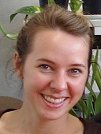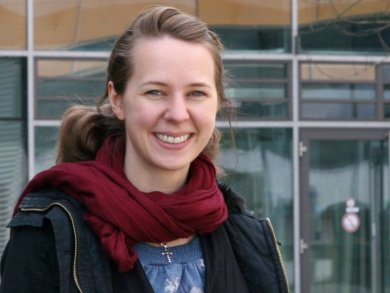Dr. Kathrin Lange, Max Born Institute for Nonlinear Optics and Short Pulse Spectroscopy, Berlin, Germany, received the 2012 Wilhelm-Ostwald Newcomer Award. She won the award for her thesis Structure and Dynamics of Water and Ions in Solution – Soft X-Ray Absorption and Emission Studies in which she describes the study of the hydrogen bond network of water with the LiXEdrom spectrometer that she developed with the support of her group. This membrane-free spectrometer allows solutions to be studied without removing the associated water by using a micrometer-thin jet.
She talks to Dr. Vera Köster, ChemViews magazine, about her research and her plans for the future.
You just received the Wilhelm-Ostwald Newcomer Award. What does this mean to you?
It was a great honor to receive this prize – especially because I gained my degree in physics. The building of the LiXEdrom spectrometer, which was the main challenge of my thesis, is a rather physics-based work. However, the applications for which the spectrometer is used, like the study of the hydrogen bond network or of materials in solution, come from other fields like chemistry and biology.
The award is given by the German Bunsen Society for Physical Chemistry (DBG, Deutsche Bunsen-Gesellschaft für Physikalische Chemie), the German Chemical Society (GDCh, Gesellschaft Deutscher Chemiker), and the Wilhelm Ostwald Society (WOG, Wilhelm-Ostwald-Gesellschaft). All these societies are chemistry orientated. So it is nice to see that societies from the field of chemistry already appreciate the first experimental studies with this spectrometer and also recognize its potential for future investigations.
What is it like to receive a prize so early in your career?
It is a great motivation for me to receive such a prize, since it is not only for what you have achieved, but it’s also connected to expectations of what comes after.
Can you please explain what you received the award for?
During my thesis I was building, together with the support of the team, the first soft X-ray-based, membrane-free absorption spectrometer for liquid samples at the BESSYII synchrotron facility at the Helmholtz Zentrum, Berlin.
The challenge of measuring liquid samples lies in the fact that soft X-rays require vacuum conditions. Normally under these conditions, solutions are not stable in their liquid phase but evaporate in the vacuum. One possible approach is to separate the liquid from the vacuum with a thin membrane, however, one cannot exclude interactions between sample and membrane. We used instead the liquid micro jet technique.
For this a very thin jet of around 10–20 µm diameter is pumped with high velocity into the vacuum. After the sample is irradiated with the soft X-rays, the liquid is frozen within a liquid nitrogen cooled container in order to keep a stable vacuum environment. The investigation of liquid samples is of high interest, since most chemical reactions take place in liquid phase and it is also the natural environment for a wide range of functional materials.
Have you used your own technique for measurements?
Oh yes. In my thesis I also show the first investigations in which we were studying the hydrogen bond network of water. We were looking at specific features in the water spectrum that are not really understood. We found that there is one feature that is very sensitive to the hydrogen bond network, so if the number of hydrogen bonds in the sample is increased, it increases in intensity.
So then you were very lucky to come up with a new technique and successful measurements.
A lot of parameters have to come together at the same time to make it work.
Usually when you are working on something that has not been done exactly like this before, a lot of things can and will go wrong. Then it is important that you stay focused, and don’t lose your motivation and your good mood. I was lucky to have a very nice environment and friendly and helpful colleagues who supported me.
How long did all this take you?
The building of the set-up took a bit less than a year. Then the measurements started, but even while you are measuring, you are still developing further. In total, my thesis took me a bit less than three years.
This is fast. Is your new method available also for other users?
Yes, the set-up is also available for users of the synchrotron. Everybody can come and apply for measurement time.
What are your doing now after your thesis?
For almost a year now, I have been at the Max Born Institute here in Berlin. I’ve learned a lot about laser physics. My aim was always to combine laser physics and synchrotron research.
I’ve just received a postdoc research grant from the Helmholtz Society which allows me to go back to the Helmholtz Center where I did my Ph.D. There I can build up my own little team and can start with a little bit more independent research.
And what are your future plans?
I am trying to get more independent research funding so that I can build a bigger team and focus further on combining the laser research that I do now in the lab with what I have learned about the synchrotron.
I will also spend some time as a guest scientist at the EPFL (École Polytechnique Fédérale de Lausanne) in Lausanne, Switzerland, in the lab of Professor Chergui. This is a good place to learn more about ultrafast spectroscopy and to get some ideas for combining laser and synchrotron based methods.
What motivates or drives you in your research?
Basically curiosity, there are a lot of open questions. And I like to learn something new every day.
What do you enjoy most about research?
Working in research has a lot of variety. Sometimes you work in a team to build a set-up with your hands, sometimes you have calm time in the office to read about the work of others or write articles yourself, or you present work at a conference. And, certainly where I was working, it is usually a very international environment, where people from all over the world come together and bring their ideas.
I also liked the applied nature of my project. Research into the hydrogen bonding in water is a topic that general people understand and can appreciate why it is important.
What else do you like doing?
Research, and especially a Ph.D. thesis, is a lot of work, so usually one doesn’t have much time for other things.
But I like making music. I’m in a little band together with my brother and some friends. We rarely play anything in public except for family celebrations – most of the time we just play for ourselves – but it’s lots of fun.
And what kind of music do you play?
Oh, it is whatever the members of our band wish to play. So it really can be anything ranging from soccer songs to church music.
Could we, for example, book you for a small party?
Sure, we would give it a try.
Great. Thank you very much for the interview.

Kathrin Lange did her Ph.D. at the Helmholtz-Zentrum Berlin for Materials and Energy, Berlin, Germany, under the supervision of Professor Emad Aziz. She is currently a staff scientist at the Max Born Institute for Nonlinear Optics and Short Pulse Spectroscopy, Berlin, Germany.
Selected Publications
- The Hydrogen Bond of Water from the Perspective of Soft X-Ray Spectroscopy,
Kathrin M. Lange, Emad F. Aziz,
Chem. Asian J. 2013, 8(2), 318–327.
DOI: 10.1002/asia.201200533 - The Chemical Bond in Carbonyl and Sulfinyl Groups Studied by Soft X-ray Spectroscopy and ab Initio Calculations,
Kaan Atak, Nicholas Engel, Kathrin M. Lange, Ronny Golnak, Malte Gotz, Mikhail Soldatov, Jan-Erik Rubensson, Nobuhiro Kosugi, Emad F. Aziz,
ChemPhysChem 2012, 13(13), 3106–3111.
DOI: 10.1002/cphc.201200314 - Origin of Dark-Channel X-ray Fluorescence from Transition-Metal Ions in Water,
Robert Seidel, Samira Ghadimi, Kathrin M. Lange, Sébastien Bonhommeau, Mikhail A. Soldatov, Ronny Golnak, Alexander Kothe, René Könnecke, Alexander Soldatov, Stephan Thürmer, Bernd Winter, Emad F. Aziz,
J. Am. Chem. Soc. 2012, 134(3), 1600–1605.
DOI: 10.1021/ja207931r - On the Origin of the Hydrogen Bond Network Nature of Water: X-Ray Absorption and Emission Spectra of Water-Acetonitrile Mixtures,
Kathrin M. Lange, René Könnecke, Mikhail Soldatov, Ronny Golnak, Jan-Erik Rubensson, Alexander Soldatov, Emad F. Aziz,
Angew. Chem. Int. Ed. 2011, 50(45), 10621–10625.
DOI: 10.1002/anie.201104161 - High resolution X-ray emission spectroscopy of water and aqueous ions using the micro-jet technique,
Kathrin M. Lange, René Könnecke, Samira Ghadimi, Ronny Golnak, Mikhail A. Soldatov, Kai F. Hodeck, Alexander Soldatov, Emad F. Aziz,
Chem. Phys. 2010, 377, 1–5.
DOI: 10.1016/j.chemphys.2010.08.023
Also of interest:
- Wilhelm-Ostwald Newcomer Award 2012
Dr. Kathrin Lange wins the Wilhelm-Ostwald Newcomer Award 2012 for the best thesis in the domain of Physical Chemistry




